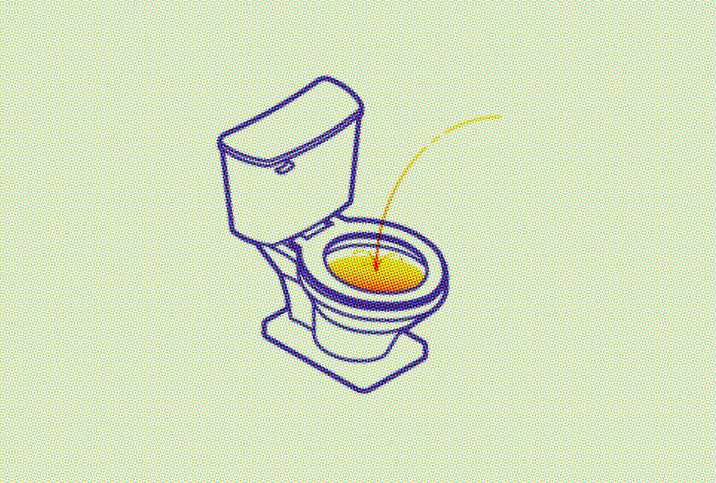You Don't Want Inflammation Here

More than a quarter of men who experience urethritis symptoms delay seeking care for longer than a week. Pain and discharge, and still, guys put off care. That's according to "Delay in Seeking Healthcare Services Following Onset of Urethritis Symptoms in Men," a study involving 385 men published in May 2019 in the journal Sexually Transmitted Diseases.
Urethritis, or inflammation of the urethra, can be asymptomatic, but common symptoms associated with the condition include urethral discharge, dysuria (a painful or burning sensation that accompanies urination), an increased urge to urinate and irritation. Although the urethra can become inflamed as a result of a pathogen passed on from a sexual partner, there are other causes.
Yet urethritis is one of the most common manifestations of sexually transmitted infections (STIs) in men, according to the study's authors, so delays in treatment are disturbing.
"The reason why it's concerning that a quarter of men, when they're concerned that they have an STI, don't seek care is because it puts them at risk and it puts their sex partners at risk," said Stephen Jordan, M.D., Ph.D., an assistant professor of medicine at Indiana University and a co-author of the 2019 study.
He added that the longer the delay, the greater the risk for infection to spread, potentially infecting the prostate and the epididymis in men, sometimes leading to fertility problems. In women, the infection can move through the cervix and into the endometrium, and can cause pelvic inflammatory disease as well as infertility.
Causes and symptoms
Many different pathogens can produce the inflammation associated with urethritis.
"It can be a multitude of factors or inputs," said Leo Doumanian, M.D., a professor of urology at the Keck School of Medicine at the University of Southern California in Los Angeles. "It's not just infections, bacteria. Actually, the vast majority of urethritis that I see in the office is not bacterial mediated."
In addition to bacterial and viral infections that can lead to urethritis, he said food triggers, trauma, poor hydration, tiny biomolecules in the urine and autoimmune disease are other possible causes.
The basis for distinguishing two different types of urethritis highlights what can commonly cause the condition.
"We classify urethritis as gonococcal—meaning it's caused by Neisseria gonorrhoeae—or nongonococcal," said David Nelson, Ph.D., a professor of microbiology and immunology at Indiana University.
Urethritis is one of the most common manifestations of sexually transmitted infections (STIs) in men.
The distinction is made, in part, because the treatment tends to differ depending on the type and its respective cause.
Common causes of nongonococcal urethritis (NGU) include sexually transmissible pathogens such as Chlamydia trachomatis (the bacteria that causes chlamydia), Mycoplasma genitalium (M. genitalium) and the protozoan parasite Trichomonas vaginalis (responsible for trichomoniasis).
While symptoms can differ depending on a person's sex, discharge and discomfort with urination (dysuria) are commonly associated with urethritis across the board, Jordan said, adding that in men, the infection occurs at the urethra meatus, the urethral orifice at the opening of the penis.
Doumanian said someone with urethritis might often feel an urgency to relieve themselves, "tingling at the tip of the penis" and other annoyances associated with inflammation in the area.
"Urethritis itself is descriptive of a constellation of symptoms," Doumanian said.
Diagnosis
According to Doumanian, a urine study is frequently used when diagnosing urethritis to determine if the sample is negative for bacteria. In addition to bacteria, he said a urinalysis looks for red and white blood cells as well as other salient surrogates, such as nitrites and leukocytes.
"There's a good proportion of people who have urethritis symptoms who will potentially have a negative urinalysis," Doumanian said. "They still have this tingling, they still have this sensation, this heaviness [and] this [feeling of heat] in the urethra."
In addition to documenting symptoms and conducting a urinalysis, doctors may perform a cystoscopy to look inside the urethra, Doumanian said.
Further, point-of-care testing can be used to differentiate gonococcal from nongonococcal urethritis, according to Nelson. A common test in this case is a Gram-stained urethral smear, at least at clinics equipped to handle such testing, which aren't widespread, according to Jordan. There aren't enough specialized technicians to do the testing.
"With Neisseria gonorrhoeae, you see these jelly bean shapes inside the host cells," Nelson said, noting that seeing those shapes allows for immediate differentiation regarding the kind and cause of urethritis.
Other barriers, in addition to a lack of clinics that conduct and analyze Gram-stained urethral smears, stand in the way of arriving at a precise diagnosis to facilitate treatment.
In an evaluation of the signs and symptoms of NGU in 220 men infected by single pathogens, researchers (including Nelson and Jordan) were unable to identify any pathogen-specific signs or symptoms of urethritis.
Jordan explained there are no point-of-care tests for chlamydia or M. genitalium, two common causes of urethritis. Clinics that specialize in STIs can usually rule out gonorrhea, but he said they can't tell people what else they may have contracted that might be inflaming the urethra.
Evelyn Toh, Ph.D., a colleague of Jordan and Nelson's at the Indiana University School of Medicine and co-author of the NGU evaluation, said there are also newer point-of-care tests being used in labs.
"But those take time," she said. "And they are quite complicated. And expensive."
Further research, also published in Sexually Transmitted Infections, revealed half of NGU cases are idiopathic, meaning they have no identified cause. Toh said idiopathic urethritis is traditionally considered a subset of NGU.
Treatment
Initial treatment of urethritis often involves antibiotics, which can have anti-inflammatory effects, Doumanian said, adding that alpha blockers such as tamsulosin can relax the flow, enhancing the efficiency and effectiveness of the urinary stream as one way to allay symptoms of urethritis.
Doumanian said drugs such as pyridium, a pain reliever that affects the urethra and urinary tract, and uribel, a drug sometimes used to treat inflammation in the same area, excrete metabolites into the urine, which can induce a soothing effect capable of calming urethritis symptoms.
Amino acids, such as L-arginine and L-citrulline, have been used anecdotally to treat urethritis, he said, mentioning there are a few more "heavy-duty medications" he sometimes uses to treat the condition when appropriate. These include Neurontin (known generically as gabapentin), which works on the nerve's ability to process painful inputs, he said.
Lubrication, such as lidocaine jelly, can be applied to ease symptoms.
For urethritis caused by the chlamydia pathogen, Nelson said azithromycin can work well, but many M. genitalium strains are now resistant to that antibiotic, which is used to treat a variety of infections.
In the National Institutes of Health-funded study he helped conduct, Nelson said most cases of idiopathic urethritis responded rather well to the standard of care therapy. But the Centers for Disease Control and Prevention (CDC) changed the standard of care last year, he noted; macrolides, antibiotics that inhibit protein synthesis in bacteria, had been the standard, but the CDC switched it to doxycycline, another drug used to treat bacterial infections.
Jordan reiterated the importance of early treatment, noting the discharge that can accompany and signal urethritis is teeming with infectious organisms, which most people would not want to pass on to a partner. It's also likely people who are symptomatic are at higher risk of transmitting the pathogen to a sex partner.
"By not seeking care, they're putting themselves and their sex partners at risk of potentially irreversible, life-threatening conditions," Jordan said.




















